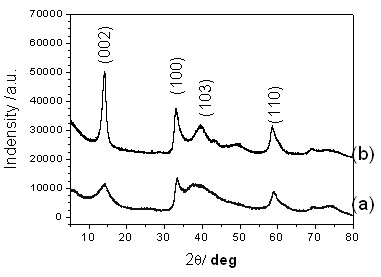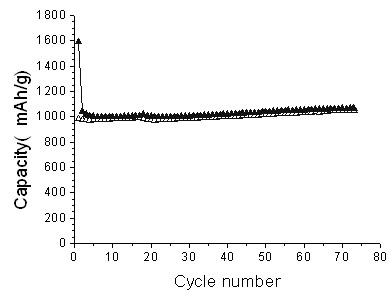Preparation method of few-layer MoS2/graphene electrochemical storage lithium composite electrode
A graphene composite and composite electrode technology, which is applied in the direction of battery electrodes, circuits, electrical components, etc., can solve the problems of large organic solvent consumption and long time, and achieve the effect of simple process and high electrochemical lithium storage specific capacity
- Summary
- Abstract
- Description
- Claims
- Application Information
AI Technical Summary
Problems solved by technology
Method used
Image
Examples
Embodiment 1
[0025] 1) Ultrasonic disperse 10.76 mmol of graphene oxide in 200 mL of deionized water, add 0.004 mol of octaalkyltrimethylammonium bromide cationic surfactant (concentration: 0.02 M), and stir thoroughly;
[0026] 2) Then add 1.4 g (5.38 mmol) ammonium thiomolybdate into it, stir well, slowly add 20 mL of hydrazine hydrate dropwise under stirring, continue stirring and heat to 95°C, under constant stirring and reflux conditions The reaction time was 7 h, and the ammonium thiomolybdate and graphene oxide were simultaneously reduced to MoS 2 and graphene, the solid product was collected by centrifugation, washed thoroughly with deionization, and then dried under vacuum at 100°C;
[0027] 3) The obtained solid product was heat-treated at 800 °C for 2 h in a nitrogen / hydrogen mixed atmosphere, the volume ratio of hydrogen in the mixed gas was 10%, and a few-layer MoS was prepared after heat treatment 2 Composite nanomaterials with graphene, using XRD and HRTEM to characterize t...
Embodiment 2
[0037] 1) Ultrasonic disperse 5.38 mmol graphene oxide in 200 mL deionized water, add 0.004 mol octaalkyltrimethylammonium bromide cationic surfactant (concentration 0.02 M), and stir thoroughly;
[0038] 2) Then add 1.4 g (5.38 mmol) ammonium thiomolybdate into it, stir well, slowly add 30 mL of hydrazine hydrate dropwise under stirring, continue stirring and heat to 95°C, under constant stirring and reflux conditions The reaction time was 5 h, and the ammonium thiomolybdate and graphene oxide were simultaneously reduced to MoS 2 and graphene, the solid product was collected by centrifugation, washed thoroughly with deionization, and then dried under vacuum at 100°C;
[0039] 3) The obtained solid product was heat-treated at 800 °C for 2 h in a nitrogen / hydrogen mixed atmosphere, and the volume ratio of hydrogen in the mixed gas was 10%, and MoS with few layers was obtained after heat treatment 2 Composite nanomaterials with graphene, using XRD and HRTEM to characterize the ...
Embodiment 3
[0045] 1) Ultrasonic disperse 16.14 mmol of graphene oxide in 200 mL of deionized water, add 0.004 mol of octaalkyltrimethylammonium bromide cationic surfactant (concentration: 0.02 M), and stir thoroughly;
[0046] 2) Then add 1.4 g (5.38 mmol) ammonium thiomolybdate into it, stir well, slowly add 40 mL of hydrazine hydrate dropwise under stirring, continuously stir and heat to 95°C, under constant stirring and reflux conditions The reaction time was 8 h, and the ammonium thiomolybdate and graphene oxide were simultaneously reduced to MoS 2 and graphene, the solid product was collected by centrifugation, washed thoroughly with deionization, and then dried under vacuum at 100°C;
[0047] 3) The obtained solid product was heat-treated at 800 °C for 2 h in a nitrogen / hydrogen mixed atmosphere, and the volume ratio of hydrogen in the mixed gas was 10%, and MoS with few layers was obtained after heat treatment 2 Composite nanomaterials with graphene, using XRD and HRTEM to charac...
PUM
 Login to View More
Login to View More Abstract
Description
Claims
Application Information
 Login to View More
Login to View More - R&D
- Intellectual Property
- Life Sciences
- Materials
- Tech Scout
- Unparalleled Data Quality
- Higher Quality Content
- 60% Fewer Hallucinations
Browse by: Latest US Patents, China's latest patents, Technical Efficacy Thesaurus, Application Domain, Technology Topic, Popular Technical Reports.
© 2025 PatSnap. All rights reserved.Legal|Privacy policy|Modern Slavery Act Transparency Statement|Sitemap|About US| Contact US: help@patsnap.com


